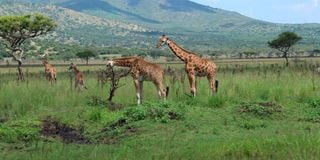Wildlife census conducted to boost conservation efforts

Giraffes at Ruma National Park in Homa Bay County on May 5,2023.
What you need to know:
- Ruma National Park is considered distinctive among all other animal habitats in the country because it hosts unique animals.
The government is conducting a wildlife census to enable agencies responsible for the protection of wild animals to make evidence-based decisions on conservation strategies and policymaking.
The census is being conducted by the Ministry of Tourism and Wildlife through the Wildlife Research and Training Institute and the Kenya Wildlife Service (KWS).
A team of researchers, scientists and environmentalists visited Ruma National Park in Homa Bay County on September 18 and 19, where they counted animals in the 120-square kilometres ground.
A similar exercise was conducted in Maasai Mara, Amboseli-Magadi and Athi-Kapiti ecosystems, Mwea National Reserve, Solio conservancy and Nakuru-Naivasha ranches.
The exercise was launched in June.
Ruma National Park is considered distinctive among all other animal habitats in the country because it hosts unique animals.
The park is renowned for its population of rare and endangered animals, especially the roan antelope, which is only found in Homa Bay.
Other notable species include the Rothschild’s giraffe, buffaloes, leopards, and numerous bird species such as the blue swallow (a migratory bird that nests in the park).
Natural Resource Management Scientist at the Ministry of Wildlife Joseph Gathua, who witnessed the launch of the exercise at the park, said the census is aimed at establishing the current status of wildlife populations, trends and their distribution across Kenya.
He said the exercise will contribute to ultimate sustainable management practices to protect the nation's rich biodiversity.
"Ruma is the fifth park where the exercise is being conducted," Mr Gathua said.
Benefits of wildlife census include biodiversity conservation, where accurate data on wildlife populations is essential for understanding the health and trends of various species.
This information aids in the development of effective conservation measures to ensure the survival of endangered and threatened species.
The census also enables decision makers to come up with informed decisions and policy formulation on conservation efforts and the preservation of Kenya's natural heritage.
It is expected that the census results will provide a solid foundation for the formulation of decisions and policies that promote coexistence of wildlife and human activities.
This will in turn help address issues such as habitat loss, human-wildlife conflict and climate change impacts.
Mr Gathua said the census also boosts sustainable tourism. Tourism is one of the top revenue earners in the country.
Mr Gathua said wildlife is a cornerstone of Kenya's tourism industry.
"Tourism supports the bottom-up economic model. A lot of people earn through the sector," he said.
After the census, data on wildlife populations will enable KWS to enhance management of national parks and reserves and community and private conservancies, ensuring they remain pristine and attractive destinations for eco-tourism, which is vital for the economy.
Wildlife census also supports scientific research on wildlife ecology, thus supporting academic research and fostering a deeper understanding of the country’s' natural heritage.
Mr Gathua said a similar exercise was conducted in 2021. ‘Tourism Cabinet secretary is required by law to submit the status of wildlife report after two years. The report is presented to the National Assembly,’ the resource scientist said.
Using data from the previous census vis-a-vis the ongoing exercise, the government will identify changes on different animal habitats.
According to Mr Gathua, habitat loss due to encroachment and settlement or infrastructural development has increased pressure on wildlife areas.
"Some areas that were purely left for wildlife are now occupied by humans. Other habitats are fragmented and animals cannot move from one area to another," he said.
Drought due to climate change was also pointed as a major threat facing wildlife in Kenya.
At Ruma, the census was conducted using a helicopter.
In other parks, the exercise was or will be conducted using fixed wing airplanes.
Mr Vasco Nyaga, an ecologist at Wildlife Research Institute, explained that the exercise is conducted on spaces measuring 500 metres, with the people responsible for counting animals covering 250 meters on the left and the right side of the helicopter.
"The system is scientific and it is conducted using studied blocks. Voice recorders are used to collect data," he said.
In the helicopter, operators use a mchine vision system to count animals.
They then use a Global Positioning System to identify areas that have been covered.
Mr Nyaga explained that the people counting animals may also use photographs to check the correct number of animals, especially the ones that are in groups.
He explained that in some circumstances, counting can be done more than twice when the number is not clear.
According to the expert, the data will be used to advise management at Ruma National Park on balancing animals.
He said there may be a need to introduce more animals or relocate some from the park to other areas depending on the generated data.
"We may also advise the management at the park to introduce animals that are not here. Ostriches, for instance, may thrive well here," the ecologist said.
Data from the exercise will be made public once the census is complete. It will be in the form of graphs, maps and figures.
At Ruma National Park, a sanctuary has been set up to accommodate the roan antelopes, where roam freely without fear of being preyed upon by other animals.
[email protected]





